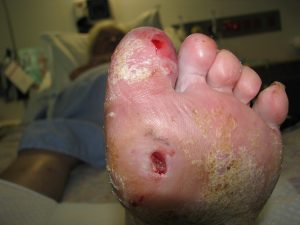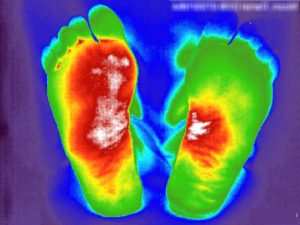 Thermal imaging can be used to better predict the healing trajectory of diabetes related foot ulcers (DRFU) than traditional visual measurements, according to a pilot study at Austin Health.
Thermal imaging can be used to better predict the healing trajectory of diabetes related foot ulcers (DRFU) than traditional visual measurements, according to a pilot study at Austin Health.
The study of both healing and non-healing ulcers in 26 patients found thermal imaging provided an earlier and more accurate indication of healing based on the area of the wound.
Healing is usually determined by a 50% reduction in the area of the ulcer between baseline and week 4.
The thermal camera creates isothermal maps of the wound bed and periwound region that can predict healing as early as two weeks from baseline.
“The most important finding of this prospective, observational study was that area of the DRFU obtained for thermal images is different to the area that is observable by eye or using colour images and that the thermal images can be used to predict the healing of DRFU,” the study said.
The isothermal images contribute information on ‘hot spots, non-uniform perfusion and increased inflammation’ that is not available on visual inspection.
“If the prognostic factors and patients’ clinical information are taken into account, the proposed feature can be used to model the healing rate of DRFU at early stages and make appropriate management decisions.”
Endocrinologist Associate Professor Elif Ekinci, the Sir Edward ‘Weary’ Dunlop Medical Research Foundation Principal Research Fellow in Metabolic Medicine at the University of Melbourne, told the limbic the study was a world first.
 “The potential advantage here is helping clinicians predict which ulcers are not healing earlier so additional things could be done such as vascularisation.”
“The potential advantage here is helping clinicians predict which ulcers are not healing earlier so additional things could be done such as vascularisation.”
“It’s a potentially very useful tool which could be used at the bedside but we have to do more work.”
According to an article in the MJA, diabetes-related foot disease is ‘Australia’s least known major health problem’ – ‘not even rating a footnote in recent national chronic disease strategies’.
A leading cause of amputations and hospitalisations and with a mortality rate worse than many cancers, the authors called for a national strategy to end avoidable amputations from diabetes-related foot disease within a generation.
Recommendations include a national research agenda with investment proportionate to the burden of disease.
Associate Professor Ekinci said she supported the call to make diabetes-related foot disease more of a priority.
“I absolutely support that. It’s a huge burden for people living with diabetes because it can really lead to disability for the time that the person is waiting for the ulcer to heal and potential concern about the need for amputation.”
“Research like this is particularly useful clinically and we will continue to do more work in this field.”